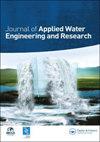聚合物吸附剂去除重金属的中心复合设计
IF 1.6
Q4 WATER RESOURCES
Journal of Applied Water Engineering and Research
Pub Date : 2020-10-21
DOI:10.1080/23249676.2020.1831978
引用次数: 4
摘要
重金属工业废水由于其毒性而引起人们的极大关注。更好的实验设计(DOE)应该应用于有效的处理过程。中心复合材料设计(CCD)的统计DOE可用于重金属去除的优化过程。使用酰胺肟改性的聚(丙烯腈-共-丙烯酸)(聚(AN-共-AA))去除镉离子(Cd2+)和铅离子(Pb2+)。CCD响应结果(Cd2+和Pb2+的去除)是通过考虑pH(A)、吸附剂剂量(B)和初始浓度(C)的自变量而获得的。在最佳条件下,Cd2+和Pb2+的去除率分别为98.90%和99.99%。回归分析表明,最佳条件为10 mg/L−1 Cd2+浓度为4.66 g.L−1吸附剂,pH 9.31和20 mg/L−1 Pb2+浓度为8.27 g.L−1吸附剂,pH 9.08。两种金属离子都产生了显著的方差分析(ANOVA)拟合不足。本文章由计算机程序翻译,如有差异,请以英文原文为准。
Central composite design of heavy metal removal using polymer adsorbent
The industrial effluents of heavy metal become a great concern because of their toxicity. The better design of experimental (DOE) should be applied for an efficient treatment process. The statistical DOE of central composite design (CCD) can be used for the optimization process of heavy metal removal. The cadmium ions (Cd2+) and lead ions (Pb2+) were removed using amidoxime modified poly(acrylonitrile-co-acrylic acid) (poly(AN-co-AA)). The CCD response result (Cd2+ and Pb2+ removal) was obtained by considering independent variables of pH (A), adsorbent dosage (B), and initial concentration (C). The experimental removal of Cd2+ and Pb2+ at optimum conditions was 98.90% and 99.99%, respectively. The regression analysis illustrated the optimum conditions were 10 mg.L−1 Cd2+ concentration with 4.66 g.L−1 adsorbent at pH 9.31, and 20 mg.L−1 Pb2+ concentration with 8.27 g.L−1 adsorbent at pH 9.08. Both of the metal ions yielded insignificant lack of fit of the analysis of variance (ANOVA).
求助全文
通过发布文献求助,成功后即可免费获取论文全文。
去求助
来源期刊

Journal of Applied Water Engineering and Research
WATER RESOURCES-
CiteScore
2.90
自引率
16.70%
发文量
31
期刊介绍:
JAWER’s paradigm-changing (online only) articles provide directly applicable solutions to water engineering problems within the whole hydrosphere (rivers, lakes groundwater, estuaries, coastal and marine waters) covering areas such as: integrated water resources management and catchment hydraulics hydraulic machinery and structures hydraulics applied to water supply, treatment and drainage systems (including outfalls) water quality, security and governance in an engineering context environmental monitoring maritime hydraulics ecohydraulics flood risk modelling and management water related hazards desalination and re-use.
 求助内容:
求助内容: 应助结果提醒方式:
应助结果提醒方式:


